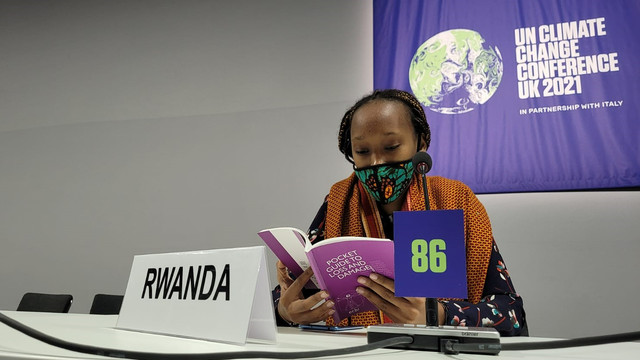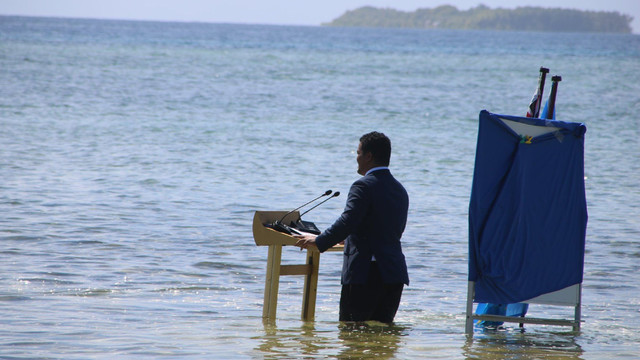Is COP26 back on track? The UN General Assembly will be a pivotal moment
While COP26 may still be on rocky ground, recent G20 and high-level ministerial meetings show signs that progress is possible – but only if G20 countries step up on the 1.5°C target and wealthy countries deliver on the US$100bn climate finance goal.


UN Secretary-General António Guterres addresses the UN General Assembly (Photo: John Gillespie via Flickr, CC BY-SA 2.0)
Success at this year's UN climate negotiations (COP26) relies on countries agreeing strong political outcomes for climate action. As the upcoming Intergovernmental Panel on Climate Change (IPCC) report is expected to show, we don’t have time to waste in reducing emissions and enabling adaptation in our economies, societies and environment.
And this urgency to act is on show. A range of recent extreme weather events – from extraordinary record-busting temperatures and attendant wildfires in the Pacific North West of America and in Siberia, to flood disasters with massive damage and loss of life in China, India and Europe – the alarm bells are ringing.
While temperature rises have not yet even reached 1.5°C on pre-industrial levels, there is plenty of evidence that impacts are more severe than anticipated for any given level of planetary warming.
With less than 100 days to go, there is more pressure than ever for COP26 to deliver. And as I’ve set out previously, the signs haven’t been good.
Recent meetings, including the G20 climate, energy and environment meetings last week and the UK-hosted ministerial held over the weekend, indicate that some earlier fractures may be starting to heal. G20 countries are now showing they have a clearer mandate to step up and show solidarity with climate-vulnerable countries ahead of COP26.
We need real progress across a number of fronts. And these recent meetings suggest this progress is possible in two particular areas: keeping the 1.5°C warming target within reach and delivering the US$100bn climate finance goal. These two issues remain a high priority for climate-vulnerable countries.
An eye on the prize: refocusing efforts on 1.5°C
One hundred Nationally Determined Contributions (NDCs) – countries’ climate action plans − have now been published, and the vast majority of these are from the least developed countries (LDCs), Small Island Developing States (SIDS) and G7 countries. G20 countries are lagging behind.
It is becoming clearer that countries are shifting their focus to the goal of limiting warming to 1.5°C by the end of the century, instead of the upper goal of 2°C in the Paris Agreement. Setting ambitions is one thing; delivering on them is another – and a big gap lies between the two. NDCs to date fall well short of the 1.5°C ambition.
Many G20 countries are yet to come through with revised or second NDCs. It is critical they do so before COP26. And to truly signal commitments to keep warming within 1.5°C, mitigation goals must be much stronger.
Further, we need to see new language agreed at COP26 to recognise unambiguously 1.5°C as the temperature goal. The negotiated text needs to respond to the new IPCC report due out next month and properly reflect the findings of the IPCC Special Report on 1.5°C which COP24 was unable to welcome due to opposition from Saudi Arabia, Trump’s US, Russia and Kuwait.
There is a compelling need to speed up the transition away from coal and fossil fuels, embed a commitment that pandemic recovery plans will align with the Paris Agreement, and make long-term strategies for rigorous decarbonisation of economies a mandatory requirement.
Climate-vulnerable countries are leading the way. Ethiopia announced one of the strongest mitigation targets to date in its new NDC submitted last week, and LDCs have outlined their joint commitment to net zero by 2050 and to be powered by 100% renewable energy by 2030 in their 2050 vision (PDF).
Delivering a believable plan: reaching the $100bn climate finance goal
A key sticking point for climate-vulnerable countries has been the apparent failure of wealthy countries to deliver the promised $100bn in climate finance per year in 2020 – the first year the target agreed in 2009 should have been met. This has substantially eroded trust and undermined climate action in many lower-income countries.
At the July ministerial, the Canadian and German governments agreed to work together to develop a delivery plan for wealthy countries to reach the $100bn target. This plan will be a critical part of rebuilding trust with climate-vulnerable countries.
But, the plan must be believable. It needs to clearly map the way forward; otherwise it will be dismissed as a distraction. The delivery plan should include public finance only − private sector finance should be in the trillions not billions and additional to the $100bn commitment by governments. It should also seek to deliver at least 50% of public climate finance towards adaptation efforts.
In addition to this delivery plan, G20 countries must set out new finance commitments ahead of COP26. And strides need to be made on improving access to climate finance so that it reaches the most vulnerable communities. Climate-vulnerable countries will be closely watching developments with the new Taskforce on Access to Climate Finance for this.
The UN General Assembly (UNGA), in September provides a unique opportunity – for the Secretary-General to host a formal climate finance pledging event, and for the launch of the delivery plan to show how the finance gaps will be filled.
UNGA: a delicate stepping stone to stronger outcomes at COP26
UNGA will be the next major meeting on the road to COP26 where countries will come together. COP26 will be weeks away, and the world will be watching for hints of what political outcomes for climate may be possible.
To show strong solidarity at UNGA and give COP26 a chance to succeed, G20 countries need to:
- Announce stronger mitigation plans to keep us within 1.5°C
- Pledge new climate finance to reach the $100bn
- Commit to a delivery plan to fill in the gaps, and
- Make progress on greater access to this finance for vulnerable countries and communities.
Without these commitments, any recent political gains will be lost and COP26 will be even further off track.




